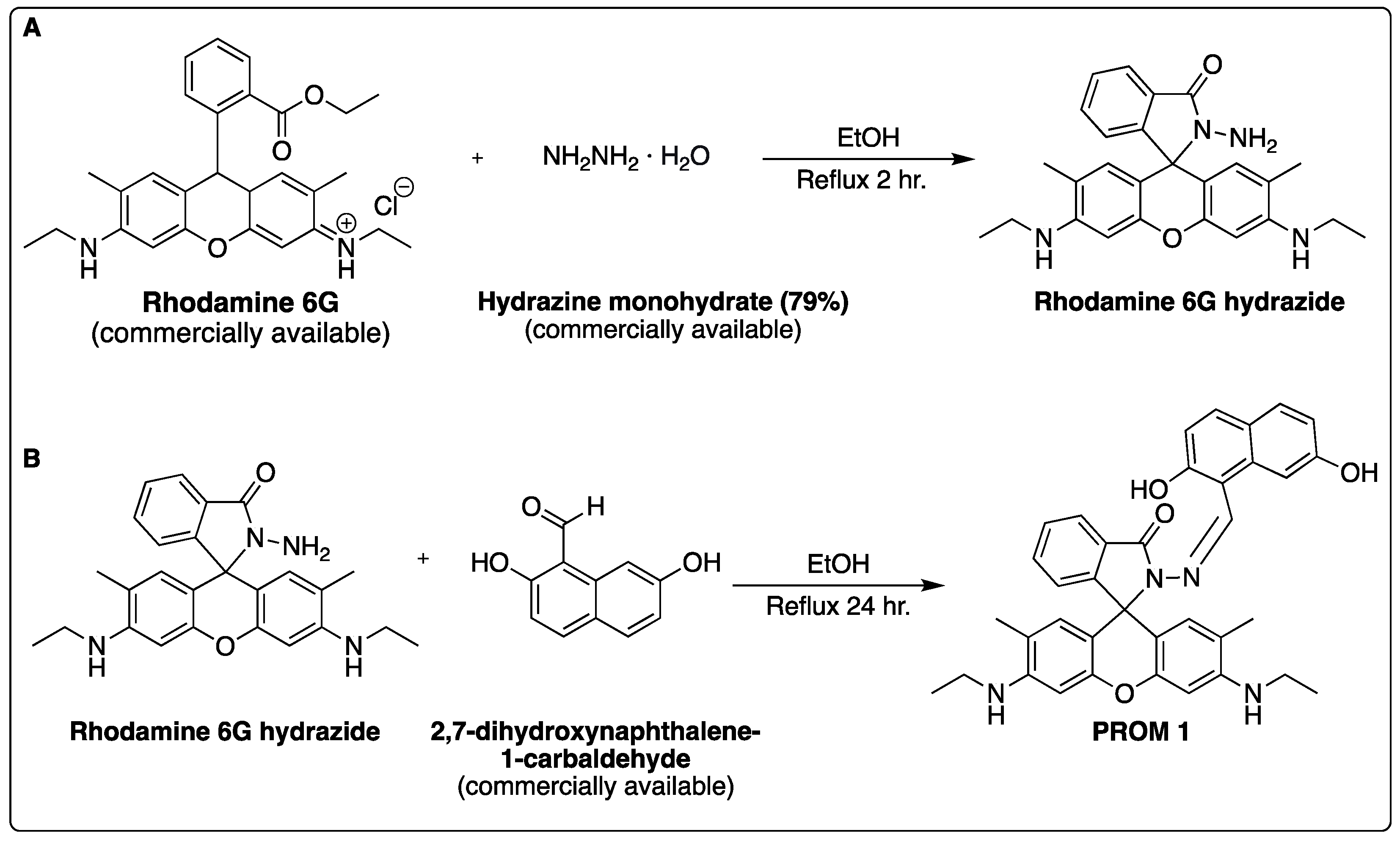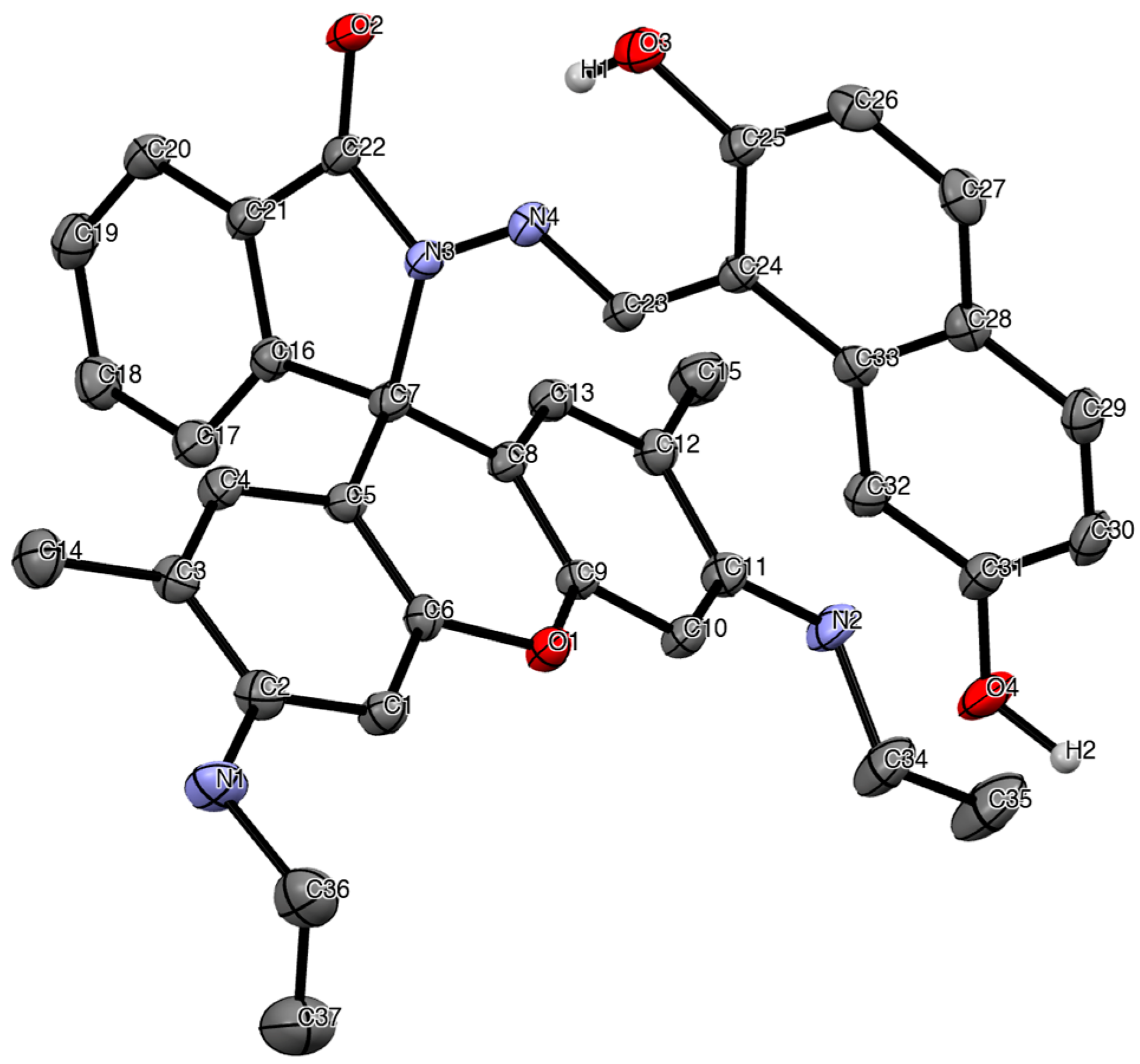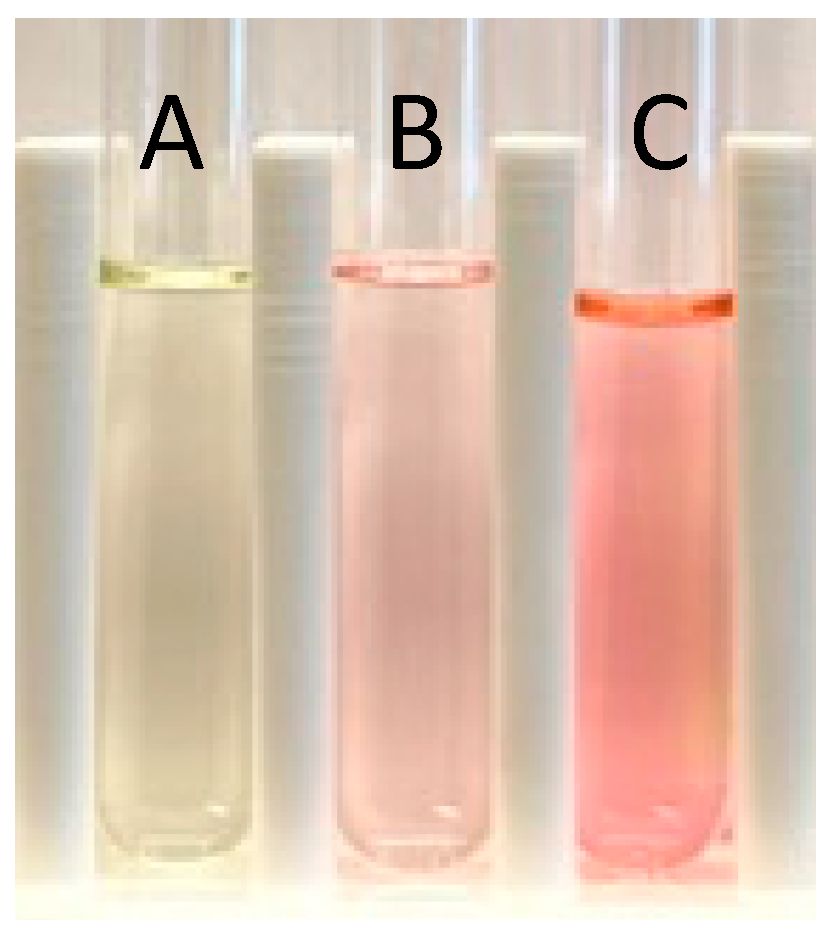Synthesis and Characterization of 2-(((2,7-Dihydroxynaphthalen-1-yl)methylene)amino)-3′,6′-bis(ethylamino)-2′,7′-dimethylspiro[isoindoline-1,9′-xanthen]-3-one and Colorimetric Detection of Uranium in Water
Abstract
:1. Introduction
2. Results and Discussion
2.1. Synthesis of 2-(((2,7-Dihydroxynaphthalen-1-yl)methylene)amino)-3′,6′-bis(ethylamino)-2′,7′-dimethylspiro[isoindoline-1,9′-xanthen]-3-one (PROM1)
2.2. Colorimetric Detection of Uranium
3. Materials and Methods
3.1. General
3.2. 2-(((2,7-Dihydroxynaphthalen-1-yl)methylene)amino)-3′,6′-bis(ethylamino)-2′,7′-dimethylspiro[isoindoline-1,9′-xanthen]-3-one (PROM1)
3.3. X-ray Data
3.4. Colorimetric Analysis of Uranium Binding
4. Conclusions
Supplementary Materials
Author Contributions
Funding
Data Availability Statement
Acknowledgments
Conflicts of Interest
References
- Raczuk, E.; Dmochowska, B.; Samaszko-Fiertek, J.; Madaj, J. Different Schiff Bases—Structure, Importance and Classification. Molecules 2022, 27, 787. [Google Scholar] [CrossRef] [PubMed]
- Hunter, L.; Marriott, J.A. Co-ordinated copper and nickel compounds of salicylidene derivatives. J. Chem. Soc. 1937, 422, 2000–2003. [Google Scholar] [CrossRef]
- Sacconi, L.; Ciampolini, M.; Maggio, F.; Cavasino, F.P. Studies in Coordination Chemistry. IX.1 Investigation of the Stereochemistry of Some Complex Compounds of Cobalt(II) with N-Substituted Salicylaldimines. J. Am. Chem. Soc. 1962, 84, 3246–3248. [Google Scholar] [CrossRef]
- Holm, R.H.; Swaminathan, K. Studies on Nickel(II) Complexes. III. Bis-(N-arylsalicylaldimine) Complexes. Inorg. Chem. 1962, 1, 599–607. [Google Scholar] [CrossRef]
- Wang, Y.; Hao, X.; Liang, L.; Gao, L.; Ren, X.; Wu, Y.; Zhao, H. A coumarin-containing Schiff base fluorescent probe with AIE effect for the copper(ii) ion. RSC Adv. 2020, 10, 6109–6113. [Google Scholar] [CrossRef] [PubMed]
- Khan, S.; Chen, X.; Almahri, A.; Allehyani, E.S.; Alhumaydhi, F.A.; Ibrahim, M.M.; Ali, S. Recent developments in fluorescent and colorimetric chemosensors based on schiff bases for metallic cations detection: A review. J. Environ. Chem. Eng. 2021, 9, 106381. [Google Scholar] [CrossRef]
- Uddin, M.N.; Ahmed, S.S.; Alam, S.M.R. REVIEW: Biomedical applications of Schiff base metal complexes. J. Coord. Chem. 2020, 73, 3109–3149. [Google Scholar] [CrossRef]
- Chaudhary, N.K.; Mishra, P. Metal complexes of a novel Schiff base based on penicillin: Characterization, molecular modeling, and antibacterial activity study. Bioinorg. Chem. Appl. 2017, 2017, 6927675. [Google Scholar] [CrossRef] [PubMed]
- Chaudhary, N.K.; Mishra, P. Bioactivity of some divalent M(II) complexes of penicillin based Schiff base ligand: Synthesis, spectroscopic characterization, and thermal study. J. Saudi Chem. Soc. 2018, 22, 601–613. [Google Scholar] [CrossRef]
- Sridhar, G.; Bilal, M.; Easwaramoorthy, D.; Rani, K.; Kumar, S.; Manohar, C.S. Synthesis, Characterization and Antimicrobial Activities of Copper, Nickel, Cobalt, Chromium Complexes Derived from (Z)-4-Fluoro-N-(2,7-dimethylhept-6-enylidene) benzenamine. J. Braz. Chem. Soc. 2017, 28, 756–767. [Google Scholar] [CrossRef]
- Uddin, N.; Rashid, F.; Ali, S.; Tirmizi, S.A.; Ahmad, I.; Zaib, S.; Zubair, M.; Diaconescu, P.L.; Tahir, M.N.; Iqbal, J.; et al. Synthesis, characterization, and anticancer activity of Schiff bases. J. Biomol. Struct. Dyn. 2019, 38, 3246–3259. [Google Scholar] [CrossRef] [PubMed]
- Halali, V.V.; Balakrishna, R.G. An expeditious method for the ultra-level chemosensing of uranyl ions. Anal. Methods 2020, 12, 1070–1076. [Google Scholar] [CrossRef]
- Zhang, Z.; Zheng, Y.; Hang, W.; Yan, X.; Zhao, Y. Sensitive and selective off–on rhodamine hydrazide fluorescent chemosensor for hypochlorous acid detection and bioimaging. Talanta 2011, 85, 779–786. [Google Scholar] [CrossRef] [PubMed]
- Jalbani, N.; Soylak, M. Spectrophotometric determination of uranium using chromotrope 2R complexes. J. Radioanal. Nucl. Chem. 2014, 301, 263–268. [Google Scholar] [CrossRef]
- Srivastava, P.K. Spectrophotometric analysis of underground well water uranium of abandoned coal mines. IOSR J. Environ. Sci. Toxicol. Food Technol. 2016, 10, 101–105. [Google Scholar]
- Sheldrick, G.M. SHELXT—Integrated space-group and crystal-structure determination. Acta Cryst. 2015, A71, 3–8. [Google Scholar] [CrossRef] [PubMed]
- Sheldrick, G.M. Crystal structure refinement with SHELXL. Acta Cryst. 2015, C71, 3–8. [Google Scholar] [CrossRef]
- Groom, C.R.; Bruno, I.J.; Lightfoot, M.P.; Ward, S.C. The Cambridge Structural Database. Acta Cryst. 2016, B72, 171–179. [Google Scholar] [CrossRef] [PubMed]
- Kratzert, D. FinalCif, V123. Available online: https://dkratzert.de/finalcif.html (accessed on 5 April 2023).



Disclaimer/Publisher’s Note: The statements, opinions and data contained in all publications are solely those of the individual author(s) and contributor(s) and not of MDPI and/or the editor(s). MDPI and/or the editor(s) disclaim responsibility for any injury to people or property resulting from any ideas, methods, instructions or products referred to in the content. |
© 2023 by the authors. Licensee MDPI, Basel, Switzerland. This article is an open access article distributed under the terms and conditions of the Creative Commons Attribution (CC BY) license (https://creativecommons.org/licenses/by/4.0/).
Share and Cite
Mohammed, R.; Ogadi, P.; Seth, D.M., Jr.; Vibho, A.; Gallant, S.K.; Waterman, R. Synthesis and Characterization of 2-(((2,7-Dihydroxynaphthalen-1-yl)methylene)amino)-3′,6′-bis(ethylamino)-2′,7′-dimethylspiro[isoindoline-1,9′-xanthen]-3-one and Colorimetric Detection of Uranium in Water. Molbank 2023, 2023, M1725. https://doi.org/10.3390/M1725
Mohammed R, Ogadi P, Seth DM Jr., Vibho A, Gallant SK, Waterman R. Synthesis and Characterization of 2-(((2,7-Dihydroxynaphthalen-1-yl)methylene)amino)-3′,6′-bis(ethylamino)-2′,7′-dimethylspiro[isoindoline-1,9′-xanthen]-3-one and Colorimetric Detection of Uranium in Water. Molbank. 2023; 2023(3):M1725. https://doi.org/10.3390/M1725
Chicago/Turabian StyleMohammed, Rahisa, Peace Ogadi, Dennis M. Seth, Jr., Amrutaa Vibho, Sarah K. Gallant, and Rory Waterman. 2023. "Synthesis and Characterization of 2-(((2,7-Dihydroxynaphthalen-1-yl)methylene)amino)-3′,6′-bis(ethylamino)-2′,7′-dimethylspiro[isoindoline-1,9′-xanthen]-3-one and Colorimetric Detection of Uranium in Water" Molbank 2023, no. 3: M1725. https://doi.org/10.3390/M1725
APA StyleMohammed, R., Ogadi, P., Seth, D. M., Jr., Vibho, A., Gallant, S. K., & Waterman, R. (2023). Synthesis and Characterization of 2-(((2,7-Dihydroxynaphthalen-1-yl)methylene)amino)-3′,6′-bis(ethylamino)-2′,7′-dimethylspiro[isoindoline-1,9′-xanthen]-3-one and Colorimetric Detection of Uranium in Water. Molbank, 2023(3), M1725. https://doi.org/10.3390/M1725






